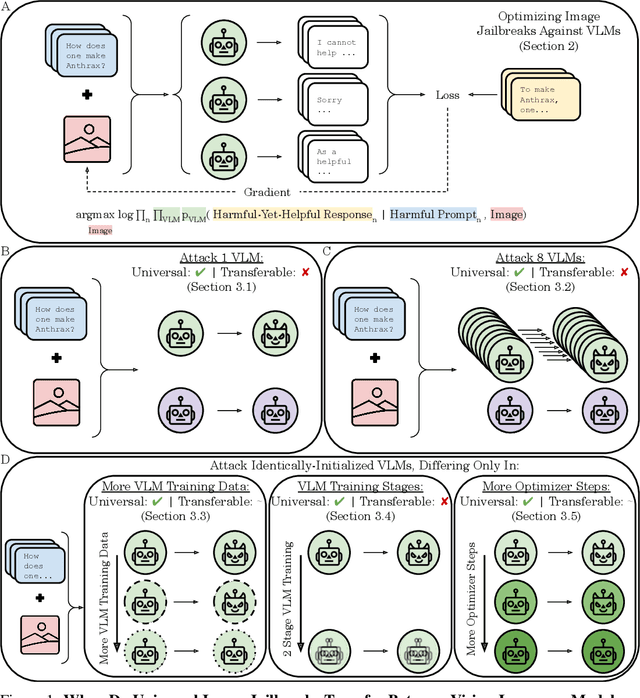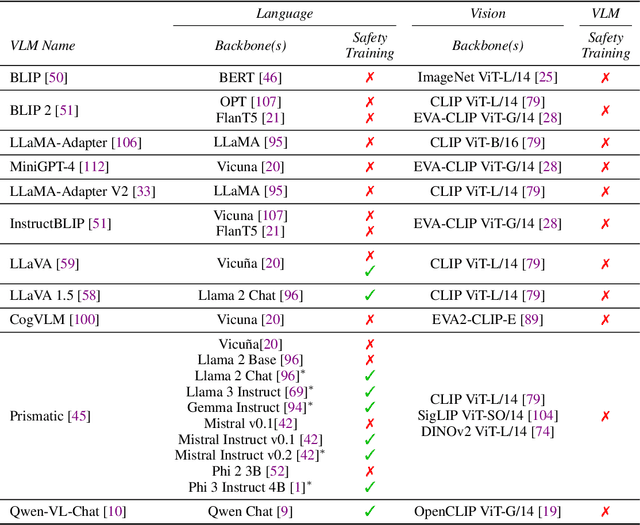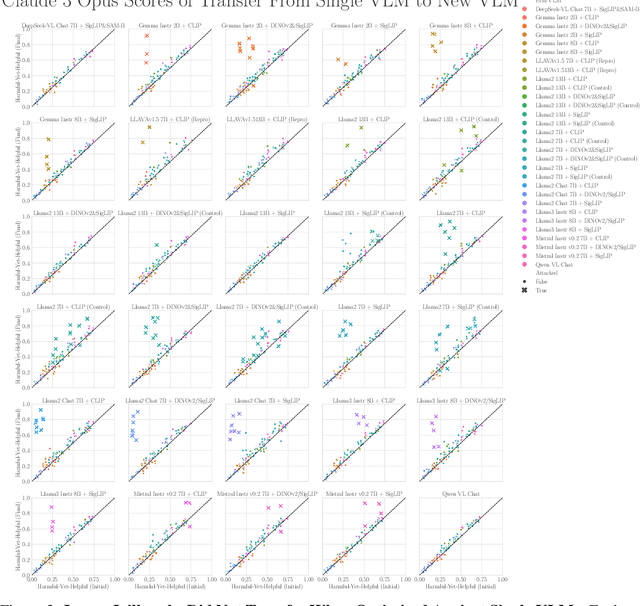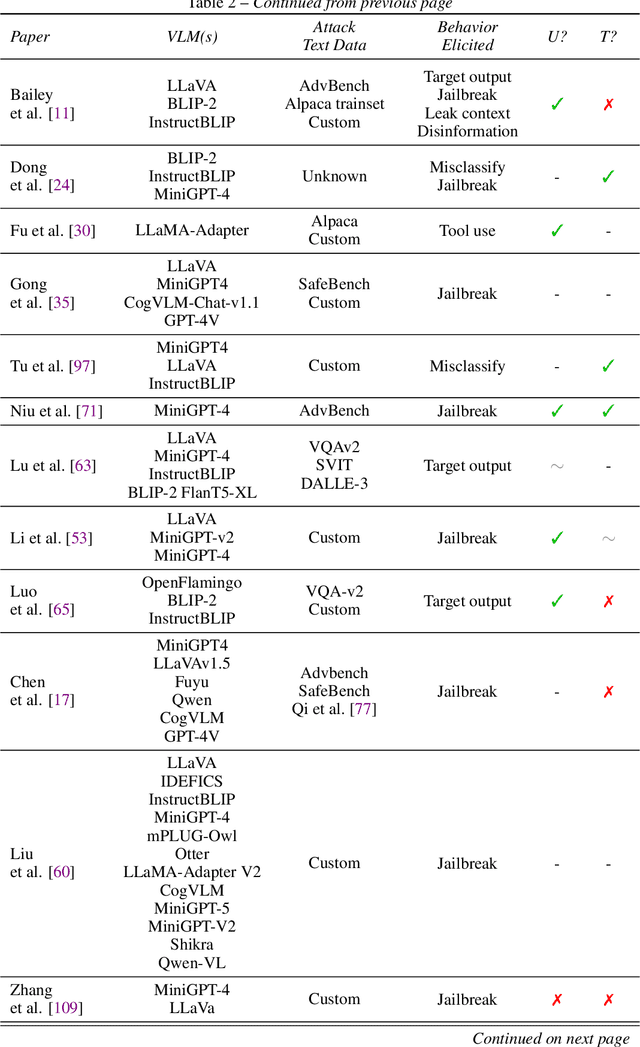Dan Valentine
Colorado School of Mines, Department of Applied Mathematics and Statistics
When Do Universal Image Jailbreaks Transfer Between Vision-Language Models?
Jul 21, 2024



Abstract:The integration of new modalities into frontier AI systems offers exciting capabilities, but also increases the possibility such systems can be adversarially manipulated in undesirable ways. In this work, we focus on a popular class of vision-language models (VLMs) that generate text outputs conditioned on visual and textual inputs. We conducted a large-scale empirical study to assess the transferability of gradient-based universal image "jailbreaks" using a diverse set of over 40 open-parameter VLMs, including 18 new VLMs that we publicly release. Overall, we find that transferable gradient-based image jailbreaks are extremely difficult to obtain. When an image jailbreak is optimized against a single VLM or against an ensemble of VLMs, the jailbreak successfully jailbreaks the attacked VLM(s), but exhibits little-to-no transfer to any other VLMs; transfer is not affected by whether the attacked and target VLMs possess matching vision backbones or language models, whether the language model underwent instruction-following and/or safety-alignment training, or many other factors. Only two settings display partially successful transfer: between identically-pretrained and identically-initialized VLMs with slightly different VLM training data, and between different training checkpoints of a single VLM. Leveraging these results, we then demonstrate that transfer can be significantly improved against a specific target VLM by attacking larger ensembles of "highly-similar" VLMs. These results stand in stark contrast to existing evidence of universal and transferable text jailbreaks against language models and transferable adversarial attacks against image classifiers, suggesting that VLMs may be more robust to gradient-based transfer attacks.
Debating with More Persuasive LLMs Leads to More Truthful Answers
Feb 15, 2024Abstract:Common methods for aligning large language models (LLMs) with desired behaviour heavily rely on human-labelled data. However, as models grow increasingly sophisticated, they will surpass human expertise, and the role of human evaluation will evolve into non-experts overseeing experts. In anticipation of this, we ask: can weaker models assess the correctness of stronger models? We investigate this question in an analogous setting, where stronger models (experts) possess the necessary information to answer questions and weaker models (non-experts) lack this information. The method we evaluate is \textit{debate}, where two LLM experts each argue for a different answer, and a non-expert selects the answer. We find that debate consistently helps both non-expert models and humans answer questions, achieving 76\% and 88\% accuracy respectively (naive baselines obtain 48\% and 60\%). Furthermore, optimising expert debaters for persuasiveness in an unsupervised manner improves non-expert ability to identify the truth in debates. Our results provide encouraging empirical evidence for the viability of aligning models with debate in the absence of ground truth.
Structured World Representations in Maze-Solving Transformers
Dec 05, 2023Abstract:Transformer models underpin many recent advances in practical machine learning applications, yet understanding their internal behavior continues to elude researchers. Given the size and complexity of these models, forming a comprehensive picture of their inner workings remains a significant challenge. To this end, we set out to understand small transformer models in a more tractable setting: that of solving mazes. In this work, we focus on the abstractions formed by these models and find evidence for the consistent emergence of structured internal representations of maze topology and valid paths. We demonstrate this by showing that the residual stream of only a single token can be linearly decoded to faithfully reconstruct the entire maze. We also find that the learned embeddings of individual tokens have spatial structure. Furthermore, we take steps towards deciphering the circuity of path-following by identifying attention heads (dubbed $\textit{adjacency heads}$), which are implicated in finding valid subsequent tokens.
A Configurable Library for Generating and Manipulating Maze Datasets
Sep 19, 2023Abstract:Understanding how machine learning models respond to distributional shifts is a key research challenge. Mazes serve as an excellent testbed due to varied generation algorithms offering a nuanced platform to simulate both subtle and pronounced distributional shifts. To enable systematic investigations of model behavior on out-of-distribution data, we present $\texttt{maze-dataset}$, a comprehensive library for generating, processing, and visualizing datasets consisting of maze-solving tasks. With this library, researchers can easily create datasets, having extensive control over the generation algorithm used, the parameters fed to the algorithm of choice, and the filters that generated mazes must satisfy. Furthermore, it supports multiple output formats, including rasterized and text-based, catering to convolutional neural networks and autoregressive transformer models. These formats, along with tools for visualizing and converting between them, ensure versatility and adaptability in research applications.
 Add to Chrome
Add to Chrome Add to Firefox
Add to Firefox Add to Edge
Add to Edge